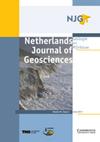The option of Roman canal construction by Drusus in the Vecht river area (the Netherlands): a geoarchaeological approach
IF 2.3
2区 地球科学
Q3 GEOSCIENCES, MULTIDISCIPLINARY
Netherlands Journal of Geosciences-Geologie En Mijnbouw
Pub Date : 2022-02-21
DOI:10.1017/njg.2022.2
引用次数: 0
Abstract
Abstract This paper presents a geoarcheological study on potential canal subsections present in the Roman-age Vecht branch of the Rhine-Meuse delta (the Netherlands).The first Roman canals in this delta were dug around 12 BC by Drusus, but their location has been the subject of debate since the 16th century, with various hypotheses proposed. Based on actual palaeogeographical knowledge of the Rhine-Meuse delta, the Utrechtse Vecht hypothesis is considered the most plausible. Within the study area, in the northern part of the Vecht system, natural sections of this river may alternate with possible artificial reaches, created at the time of Drusus. Such artificial canals, being part of an otherwise natural channel belt system, can widen and deepen overtime, eroding all or most of the recognizable features associated with their original construction. As study area was chosen a relatively straight section of the Vecht between two former lakes. Two approaches were used. The first approach centred upon mapping channel morphology and recording sediment stratigraphy of the river deposits through detailed auger coring. Results corroborated the hypothesis of an originally straight feature (landform), confirming that it might have started life as a dug course, but not providing preserved archaeological remains of this stage. The second approach was chronological, whereby a programme of 14C dating was undertaken to refine the understanding of the origin and development of this reach of the Vecht, allowing earlier chronological investigations to be further contextualised and reassessed. A significant challenge to understand age control and floodplain evolution is the degradation of the top of the clayey peat that was observed below the levee deposits; this degradation is due to the lowering of groundwater levels and causes the end of peat growth to be dated as older than it actually is. Using new radiocarbon dates we have reconstructed that the Overmeer-Nigtevecht reach of the Vecht between two former lakes started life as a straight channel. We have constrained its age to be closer to the time of Drusus’ activities (early Roman age). Although we have not found in situ remains of Drusus canal(s), these two new insights make the Vecht option, effectuated by a series of short canals, more likely to be the Drusus canal(s).德鲁苏斯在维赫特河地区(荷兰)修建罗马运河的选择:一种地质考古方法
摘要:本文介绍了在莱茵河-默兹河三角洲(荷兰)罗马时代韦赫特分支存在的潜在运河亚段的地质考古研究。第一条罗马运河是在公元前12年左右由德鲁苏斯在这个三角洲挖掘的,但自16世纪以来,它们的位置一直是争论的主题,提出了各种各样的假设。根据对莱茵河-默兹河三角洲的实际古地理知识,乌特勒支兹河假说被认为是最合理的。在研究区域内,在Vecht系统的北部,这条河的自然部分可能与德鲁苏斯时期创造的人工河段交替。这些人工运河,作为自然水道带系统的一部分,可能会随着时间的推移而变宽和加深,侵蚀所有或大部分与原始结构相关的可识别特征。作为研究区域,我们选择了两个以前的湖泊之间相对笔直的一段。采用了两种方法。第一种方法集中于绘制河道形态,并通过详细的螺旋钻取心记录河流沉积物的沉积物地层。结果证实了一个原始笔直的特征(地形)的假设,证实了它可能是作为一个挖掘的过程开始的,但没有提供这个阶段的保存下来的考古遗迹。第二种方法是时间顺序,通过14C测年计划来完善对这一范围的起源和发展的理解,允许早期的时间顺序调查进一步背景化和重新评估。了解年龄控制和河漫滩演化的一个重大挑战是在堤防沉积物下方观察到的粘土泥炭顶部的退化;这种退化是由于地下水位的降低,导致泥炭生长结束的时间比实际时间要早。利用新的放射性碳测年法,我们重建了位于两个湖泊之间的奥弗米尔-尼特韦希特河段最初是一条笔直的河道。我们把它的年代限定在更接近德鲁苏斯活动的时代(早期罗马时代)。虽然我们还没有发现德鲁苏斯运河的原位遗迹,但这两个新的发现使得由一系列短运河组成的Vecht选项更有可能是德鲁苏斯运河。
本文章由计算机程序翻译,如有差异,请以英文原文为准。
求助全文
约1分钟内获得全文
求助全文
来源期刊
CiteScore
4.00
自引率
25.90%
发文量
14
审稿时长
>12 weeks
期刊介绍:
Netherlands Journal of Geosciences - Geologie en Mijnbouw is a fully open access journal which publishes papers on all aspects of geoscience, providing they are of international interest and quality. As the official publication of the ''Netherlands Journal of Geosciences'' Foundation the journal publishes new and significant research in geosciences with a regional focus on the Netherlands, the North Sea region and relevant adjacent areas. A wide range of topics within the geosciences are covered in the journal, including "geology, physical geography, geophyics, (geo-)archeology, paleontology, hydro(geo)logy, hydrocarbon exploration, modelling and visualisation."
The journal is a continuation of Geologie and Mijnbouw (published by the Royal Geological and Mining Society of the Netherlands, KNGMG) and Mededelingen Nederlands Instituut voor Toegepaste Geowetenschappen (published by TNO Geological Survey of the Netherlands). The journal is published in full colour.

 求助内容:
求助内容: 应助结果提醒方式:
应助结果提醒方式:


